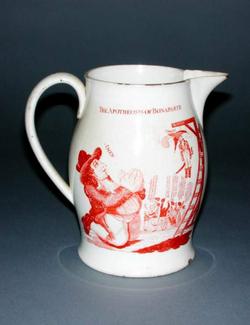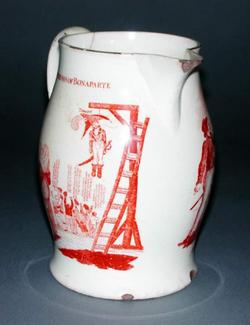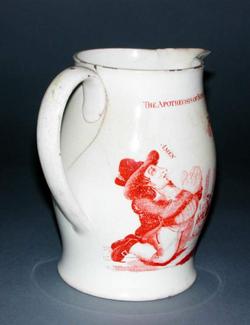Current Location: In storage
Titles
Bonaparte jug
Maker(s)
Factory:
unidentified English pottery
Entities
Categories
Description
Creamware lead-glazed and transfer-printed in red.
Pale creamcoloured earthenware covered with a clear lead-glaze and transfer-printed overglaze in red, using the glue bat method. The wheel-thrown bulbous jug has a loop handle and a sparrow’s beak lip. It is printed on one side with an image bearing the title ‘THE APOTHEOSIS OF BONAPARTE’. This image represents John Bull, kneeling and saying ‘AMEN’ opposite a gibbet which Napoleon hangs. Napoleon has a large sword and hat and is labelled ‘TYRANT’. Against the gibbet leans a ladder with inscriptions on the rungs: (top to bottom) ‘Revenge’; ‘Madrid Massacre’; ‘Hanover Pillaged’; ‘Holland Ruined’; ‘Switzerland enslaved’; 'Jaffa Soup 300 Sick’; ‘El Arish 5000 Turks’; ‘Alexandria Massacre’; ‘In gratitude to Barras’. Beneath the gibbet is a crowd of figures with inscriptions describing their cries: (left to right) ‘Ah Mynheer der Gran Bonaparte haf make oon big Mistook about being God in dis Earth’; ‘Enemy ov la Suisse ov Tell A boys Reding & la libbertay’; ‘Oh boderation long life to Ireland I tought we would catch the tief he wanted to palaver me’; ‘Dat be ton plagues of Yarmany gone in a Kick Vid a great big Sword dat I wich dey giv me for I want it by by’; 'Ala lantern Ala lantern Vive la France A bas le Corsican et tous meurtrier et scelerets Vive Johnny Bull’. Printed on the other side of the jug is an image entitled ‘A SPANISH PATRIOT’, which represents a British sailor handing a scroll labelled ‘COMMERCE’ to a Spanish soldier with a ribbon inscribed ‘LONG LIVE FERDINAND VII’.
Notes
History note: Provenance unidentified before Mary Casey, 29B Lincolns Inn Fields; Mary Casey sold for £2.5 on 18 May 1910 to Dr J.W.L. Glaisher, FRS, Trinity College, Cambridge
Legal notes
Dr J.W.L. Glaisher Bequest
Measurements and weight
Height: 14.5 cm
Width: 15.6 cm
Acquisition and important dates
Method of acquisition: Bequeathed
(1928-12-07)
by
Glaisher, J. W. L., Dr
Dating
19th Century, Early
George III
Production date:
circa
AD 1803
Note
‘The Apotheosis of Bonaparte’ is copied from a broadside by Woodthorpe, published by John Badcock of Paternoster Row on 10 August 1803.
Transfer printing was introduced to English pottery in the second half of the 18th century. Until recently, it was believed that transfer printed wares of the 18th and early 19th centuries were made using tissue paper to transfer the image onto the object from an engraved copper plate. Ceramic printing ink would be applied to the copper plate so that the engraved lines were filled; the plate would then be passed through a printing press to transfer the image to a sheet of tissue paper and the printed tissue paper placed on the ceramic and rubbed to transfer the design. However, Paul Holdway has demonstrated that most early transfer-printed ware uses another technique, one which involved the use of glue bats. This technique also relied on a copper plate but it was linseed oil, rather than ink, that was applied. The bat, a thin sheet of animal glue, would be pressed onto the oiled plate and then applied to the ware. Once the bat was removed, the ware was dusted with powdered metallic oxide, which adhered to the oil, and fired to fix the design. For round-bodied vessels like this jug, this technique had a distinct advantage over the tissue paper method: whereas tissue paper wrinkles when it is applied to a curved object, a flexible glue bat stretches round the shape. There is evidence that this jug was decorated using the glue bat technique: there are a number of small bubble-like interruptions to the design. Such flaws are a hallmark of glue bat printed wares, occurring where pockets of air or grains of dirt are trapped between the bat and the object.
People, subjects and objects depicted
Components of the work
Body
Handle
Materials used in production
cream coloured
Earthenware
Lead-glaze
Techniques used in production
Lead-glazing
Inscription or legends present
Inscription present: title of print
- Text: 'THE APOTHEOSIS OF BONAPARTE’
- Location: Over print of Napoleon being hung on side of jug
- Method of creation: Transfer-printed in red
- Type: Inscription
- Text: 'Revenge'
- Location: On top rung of ladder in 'Apotheosis' print
- Method of creation: Transfer-printed in red
- Type: Inscription
- Text: ‘Madrid Massacre’
- Location: On rung of ladder in 'Apotheosis' print
- Method of creation: Transfer-printed in red
- Type: Inscription
- Text: 'Hanover Pillaged'
- Location: On rung of ladder in 'Apotheosis' print
- Method of creation: Transfer-printed in red
- Type: Inscription
- Text: ‘Holland Ruined’
- Location: On rung of ladder in 'Apotheosis' print
- Method of creation: Transfer-printed in red
- Type: Inscription
- Text: ‘Switzerland Enslaved’
- Location: On rung of ladder in 'Apotheosis' print
- Method of creation: Transfer-printed in red
- Type: Inscription
- Text: 'Jaffa Soup 300 Sick'
- Location: On rung of ladder in 'Apotheosis' print
- Method of creation: Transfer-printed in red
- Type: Inscription
- Text: 'El Arish 5000 Turks’
- Location: On rung of ladder in 'Apotheosis' print
- Method of creation: Transfer-printed in red
- Type: Inscription
- Text: ‘Alexandria Massacre’
- Location: On rung of ladder in 'Apotheosis' print
- Method of creation: Transfer-printed in red
- Type: Inscription
- Text: ‘In gratitude to Barras’
- Location: On bottom rung of ladder in 'Apotheosis' print
- Method of creation: Transfer-printed in red
- Type: Inscription
- Text: 'Ah Mynheer der Gran Bonaparte haf make oon big Mistook about being God in dis Earth’
- Location: Over the crowd below the gibbet in 'Apotheosis' print
- Method of creation: Transfer-printed in red
- Type: Inscription
- Text: ‘Enemy ov la Suisse ov Tell A boys Reding & la libbertay’
- Location: Over the crowd below the gibbet in 'Apotheosis' print
- Method of creation: Transfer-printed in red
- Type: Inscription
- Text: ‘Oh boderation long life to Ireland I tought we would catch the tief he wanted to palaver me’
- Location: Over the crowd below the gibbet in 'Apotheosis' print
- Method of creation: Transfer-printed in red
- Type: Inscription
- Text: ‘Dat be ton plagues of Yarmany gone in a Kick Vid a great big Sword dat I wich dey giv me for I want it by by’
- Location: Over the crowd below the gibbet in 'Apotheosis' print
- Method of creation: Transfer-printed in red
- Type: Inscription
- Text: 'Ala lantern Ala lantern Vive la France A bas le Corsican et tous meurtrier et scelerets Vive Johnny Bull’
- Location: Over the crowd below the gibbet in the 'Apotheosis' print
- Method of creation: Transfer-printed in red
- Type: Inscription
- Text: 'AMEN'
- Location: Over kneeling John Bull in the 'Apotheosis' print
- Method of creation: Transfer-printed in red
- Type: Inscription
- Text: ‘A SPANISH PATRIOT’
- Location: Over print of sailor and soldier on side of jug
- Method of creation: Transfer-printed in red
- Type: Inscription
- Text: 'COMMERCE'
- Location: On scroll held by sailor in 'Patriot' print
- Method of creation: Transfer-printed in red
- Type: Inscription
- Text: ‘LONG LIVE FERDINAND VII’
- Location: On ribbon held by solider in 'Patriot' print
- Method of creation: Transfer-printed in red
- Type: Inscription
References and bibliographic entries
Identification numbers
Accession number: C.736-1928
Primary reference Number: 75951
Old catalogue number: 3136
Stable URI
Audit data
Created: Saturday 6 August 2011
Updated: Monday 29 April 2024
Last processed: Tuesday 15 July 2025
Associated departments & institutions
Owner or interested party:
The Fitzwilliam Museum
Associated department:
Applied Arts








